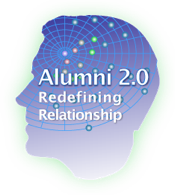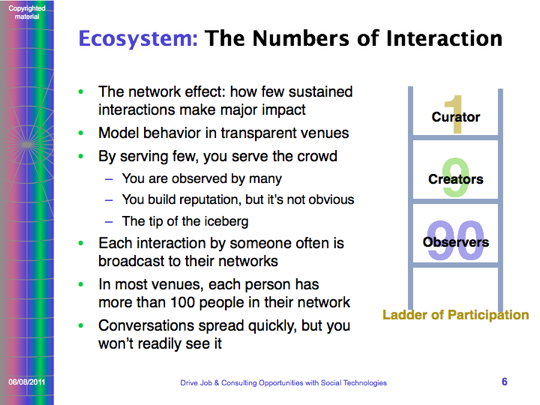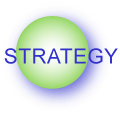 The short guide to forum outreach reveals how experiential social media teams can tap forums’ unique opportunity to engage users, using a three-stage model. Forums are vital to relationship building with people with specific interests. They are consistently the most people-centric platform type according to CSRA’s research in such diverse industries as healthcare, consumer products, financial services, government, and nonprofits. As such, although they are very human and social, forums are distinct from social media, which often enables social actions oriented to content sharing and short exchanges. The short guide to forum outreach reveals how experiential social media teams can tap forums’ unique opportunity to engage users, using a three-stage model. Forums are vital to relationship building with people with specific interests. They are consistently the most people-centric platform type according to CSRA’s research in such diverse industries as healthcare, consumer products, financial services, government, and nonprofits. As such, although they are very human and social, forums are distinct from social media, which often enables social actions oriented to content sharing and short exchanges.
In some ways, forums are the polar opposite of social media because their DNA is threaded discussions, which enable long conversations among many members. Even more exciting, the most passionate members are often members of several forums that are relevant to your stakeholders and workstreams.
[…]
 Experiential Social Media and Business Intimacy shows how social media grounded in customer experience holds the key to trust, relationship and profit. When businesses discover, invite, and build trusted relationships with people in digital public, their actions speak loudly to the silent, ten times larger audience that’s observing the process. In addition, “accidents” are the express lane to developing trust and business intimacy. Experiential Social Media and Business Intimacy shows how social media grounded in customer experience holds the key to trust, relationship and profit. When businesses discover, invite, and build trusted relationships with people in digital public, their actions speak loudly to the silent, ten times larger audience that’s observing the process. In addition, “accidents” are the express lane to developing trust and business intimacy.
“Customer experience” directly leads to customer preference and more share of wallet, although most business owners and executives dismiss it as a buzzword. As practiced by CSRA since 2006, experiential social media is a group of practices that deepen intimacy with customers and increase profit. “Social” information is the currency of business intimacy. Here I’ll outline how this enchilada rolls, so you can begin to use experiential to increase customers’ value and your profit.
[…]
Using the Relationship Value Map to Optimize Your Social Networks is a step-by-step approach to prioritizing your firm’s interactions in social networks to significantly improve the return on your team’s time.

CSRA’s Relationship Value Map is a simple but invaluable tool you can use to organize your social networks to meet your personal or business goals better. Its Interest and Trust vectors intersect to create four quadrants for your connections. I designed it when working with individual executive clients in 2009, but CSRA uses it with enterprise clients as well, especially those with direct (B2B) sales forces who need to prioritize their relationship building activities.
[…]
 In Why Lie?, Seth Godin points out that prospects of (B2B) salespeople often lie because they do not want their decisions to be questioned by salespeople: “… when we announce that we’ve made the decision to hire someone else, or when we tell the pitching entrepreneur we don’t like her business model, or when we clearly articulate why we’re not going to do business, the salesperson responds by questioning the judgment of the prospect.” In Why Lie?, Seth Godin points out that prospects of (B2B) salespeople often lie because they do not want their decisions to be questioned by salespeople: “… when we announce that we’ve made the decision to hire someone else, or when we tell the pitching entrepreneur we don’t like her business model, or when we clearly articulate why we’re not going to do business, the salesperson responds by questioning the judgment of the prospect.”
Great insight, but it pre-supposes a lack of trust that is totally outdated and unnecessary. Let’s review how this comes about and how to disrupt the whole cycle.
[…]
Evolving National-Global Recruiting and Sales with Social Business shows how firms can increase quality of recruits and sales leads while cutting costs.
 Social networks can help organizations, whether commercial, nonprofit or government, to significantly improve their efficiency in business processes like recruiting, sales and service. This is what we call “Enterprise Process Innovation” because, by using social networks to create and nurture relationships with alumni, your employees can diminish the time required to accomplish tasks within these processes. It’s well known that most alumni, former employees, move to firms that are related to your business (adjacent in the value chain) or complementary in some way. Yes, some move to competitors, but they are usually in the minority. Social networks, by significantly reducing the cost of having relevant, quality conversations, make robust employee-alumni networks actionable as never before. Social networks can help organizations, whether commercial, nonprofit or government, to significantly improve their efficiency in business processes like recruiting, sales and service. This is what we call “Enterprise Process Innovation” because, by using social networks to create and nurture relationships with alumni, your employees can diminish the time required to accomplish tasks within these processes. It’s well known that most alumni, former employees, move to firms that are related to your business (adjacent in the value chain) or complementary in some way. Yes, some move to competitors, but they are usually in the minority. Social networks, by significantly reducing the cost of having relevant, quality conversations, make robust employee-alumni networks actionable as never before.
[…]
Using Social Networks for Recruiting and Sales shows how firms can increase quality of recruits and sales leads while cutting costs.
 Social networks can help organizations, whether commercial, nonprofit or government, to significantly improve their efficiency in business processes like recruiting, sales and service. This is what we call “Enterprise Process Innovation” because, by using social networks to create and nurture relationships with alumni, your employees can diminish the time required to accomplish tasks within these processes. It’s well known that most alumni, former employees, move to firms that are related to your business (adjacent in the value chain) or complementary in some way. Yes, some move to competitors, but they are usually in the minority. Social networks, by significantly reducing the cost of having relevant, quality conversations, make robust employee-alumni networks actionable as never before. Social networks can help organizations, whether commercial, nonprofit or government, to significantly improve their efficiency in business processes like recruiting, sales and service. This is what we call “Enterprise Process Innovation” because, by using social networks to create and nurture relationships with alumni, your employees can diminish the time required to accomplish tasks within these processes. It’s well known that most alumni, former employees, move to firms that are related to your business (adjacent in the value chain) or complementary in some way. Yes, some move to competitors, but they are usually in the minority. Social networks, by significantly reducing the cost of having relevant, quality conversations, make robust employee-alumni networks actionable as never before.
All organizations (I’ll use “firm” to denote for profit, government and nonprofit) have business processes that benefit from relevant insight and introductions from other people: insight about the situation of the prospect, where the best sources of new […]

Most of us are familiar with Forrester’s Ladder of Participation, but using it to build engagement and community still escapes most individuals and organizations, so here I’ll offer a short treatment within the context of Facebook [click graphic right to enlarge]. The profound insight is that 90% of people in a social venue observe without interacting. 9% are the creators, they tweet, blog and make themselves known. 1% are curators, they sort and categorize content. Whether you are on LinkedIn, Facebook or authoring a blog, you only hear 10% of the people, but you are affecting 100% of the people. If you don’t know that, you might think your online activities were going unnoticed. Now I’ll turn to how this works in Facebook.
[…]
 Facebook Pages and Groups are rapidly becoming like websites or phone numbers—overwhelmingly banal. Last year, it was still novel for many companies and governments to launch Pages or Groups, but 2010-2011 is proving to be the inflection point: people merely expect Facebook presence because every organization has one. In step with this, the competition for Fans’ (now “Likes”) attention on Facebook is high and will continue to get higher. That said, as difficult as it is, launching and growing a powerful Facebook presence is eminently doable with the right strategy and execution. Here I will share some of my notes with a current engagement for how to grow a quality Fan base by building and leveraging a network around your presence. By the Way, Pages and Groups share similarities but they are distinct in their functionality. This post will focus mostly on Pages, but many of its techniques will work with Groups as well. Facebook Pages and Groups are rapidly becoming like websites or phone numbers—overwhelmingly banal. Last year, it was still novel for many companies and governments to launch Pages or Groups, but 2010-2011 is proving to be the inflection point: people merely expect Facebook presence because every organization has one. In step with this, the competition for Fans’ (now “Likes”) attention on Facebook is high and will continue to get higher. That said, as difficult as it is, launching and growing a powerful Facebook presence is eminently doable with the right strategy and execution. Here I will share some of my notes with a current engagement for how to grow a quality Fan base by building and leveraging a network around your presence. By the Way, Pages and Groups share similarities but they are distinct in their functionality. This post will focus mostly on Pages, but many of its techniques will work with Groups as well.
[…]
Strategic Web 2.0 Competencies (SWCs) represent a cornerstone of an organization’s effectiveness with social business. They encompass competencies from current and emerging practices on social networking and Web 2.0. […]
Digital social networks are transforming every field of human endeavor because they change the economics of how people discover, develop and maintain relationships. Therefore, social networks propose a revolution in communication is similar in scope to Ford’s invention of the assembly line for fabrication but executives don’t understand it. This post […]
|
|
 The short guide to forum outreach reveals how experiential social media teams can tap forums’ unique opportunity to engage users, using a three-stage model. Forums are vital to relationship building with people with specific interests. They are consistently the most people-centric platform type according to CSRA’s research in such diverse industries as healthcare, consumer products, financial services, government, and nonprofits. As such, although they are very human and social, forums are distinct from social media, which often enables social actions oriented to content sharing and short exchanges.
The short guide to forum outreach reveals how experiential social media teams can tap forums’ unique opportunity to engage users, using a three-stage model. Forums are vital to relationship building with people with specific interests. They are consistently the most people-centric platform type according to CSRA’s research in such diverse industries as healthcare, consumer products, financial services, government, and nonprofits. As such, although they are very human and social, forums are distinct from social media, which often enables social actions oriented to content sharing and short exchanges.
 Experiential Social Media and Business Intimacy shows how social media grounded in customer experience holds the key to trust, relationship and profit. When businesses discover, invite, and build trusted relationships with people in digital public, their actions speak loudly to the silent, ten times larger audience that’s observing the process. In addition, “accidents” are the express lane to developing trust and business intimacy.
Experiential Social Media and Business Intimacy shows how social media grounded in customer experience holds the key to trust, relationship and profit. When businesses discover, invite, and build trusted relationships with people in digital public, their actions speak loudly to the silent, ten times larger audience that’s observing the process. In addition, “accidents” are the express lane to developing trust and business intimacy.
 In Why Lie?, Seth Godin points out that prospects of (B2B) salespeople often lie because they do not want their decisions to be questioned by salespeople: “… when we announce that we’ve made the decision to hire someone else, or when we tell the pitching entrepreneur we don’t like her business model, or when we clearly articulate why we’re not going to do business, the salesperson responds by questioning the judgment of the prospect.”
In Why Lie?, Seth Godin points out that prospects of (B2B) salespeople often lie because they do not want their decisions to be questioned by salespeople: “… when we announce that we’ve made the decision to hire someone else, or when we tell the pitching entrepreneur we don’t like her business model, or when we clearly articulate why we’re not going to do business, the salesperson responds by questioning the judgment of the prospect.” Social networks can help organizations, whether commercial, nonprofit or government, to significantly improve their efficiency in business processes like recruiting, sales and service. This is what we call “Enterprise Process Innovation” because, by using social networks to create and nurture relationships with alumni, your employees can diminish the time required to accomplish tasks within these processes. It’s well known that most alumni, former employees, move to firms that are related to your business (adjacent in the value chain) or complementary in some way. Yes, some move to competitors, but they are usually in the minority. Social networks, by significantly reducing the cost of having relevant, quality conversations, make robust employee-alumni networks actionable as never before.
Social networks can help organizations, whether commercial, nonprofit or government, to significantly improve their efficiency in business processes like recruiting, sales and service. This is what we call “Enterprise Process Innovation” because, by using social networks to create and nurture relationships with alumni, your employees can diminish the time required to accomplish tasks within these processes. It’s well known that most alumni, former employees, move to firms that are related to your business (adjacent in the value chain) or complementary in some way. Yes, some move to competitors, but they are usually in the minority. Social networks, by significantly reducing the cost of having relevant, quality conversations, make robust employee-alumni networks actionable as never before.
 Facebook Pages and Groups are rapidly becoming like websites or phone numbers—overwhelmingly banal. Last year, it was still novel for many companies and governments to launch Pages or Groups, but 2010-2011 is proving to be the inflection point: people merely expect Facebook presence because every organization has one. In step with this, the competition for Fans’ (now “Likes”) attention on Facebook is high and will continue to get higher. That said, as difficult as it is, launching and growing a powerful Facebook presence is eminently doable with the right strategy and execution. Here I will share some of my notes with a current engagement for how to grow a quality Fan base by building and leveraging a network around your presence. By the Way, Pages and Groups share similarities but they are distinct in their functionality. This post will focus mostly on Pages, but many of its techniques will work with Groups as well.
Facebook Pages and Groups are rapidly becoming like websites or phone numbers—overwhelmingly banal. Last year, it was still novel for many companies and governments to launch Pages or Groups, but 2010-2011 is proving to be the inflection point: people merely expect Facebook presence because every organization has one. In step with this, the competition for Fans’ (now “Likes”) attention on Facebook is high and will continue to get higher. That said, as difficult as it is, launching and growing a powerful Facebook presence is eminently doable with the right strategy and execution. Here I will share some of my notes with a current engagement for how to grow a quality Fan base by building and leveraging a network around your presence. By the Way, Pages and Groups share similarities but they are distinct in their functionality. This post will focus mostly on Pages, but many of its techniques will work with Groups as well.